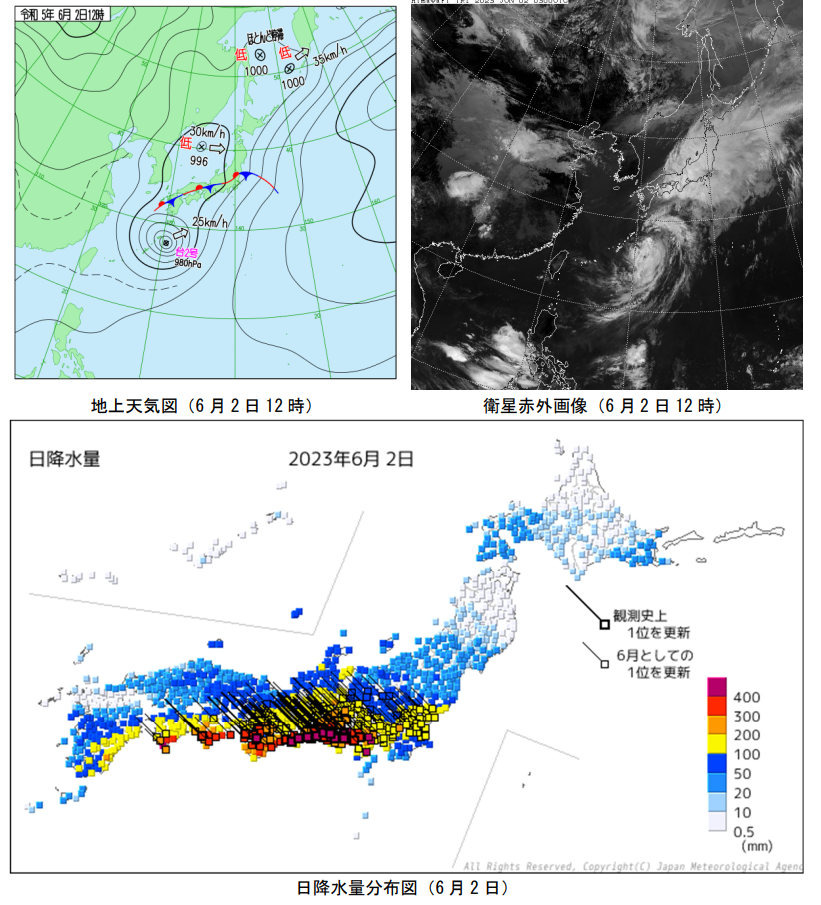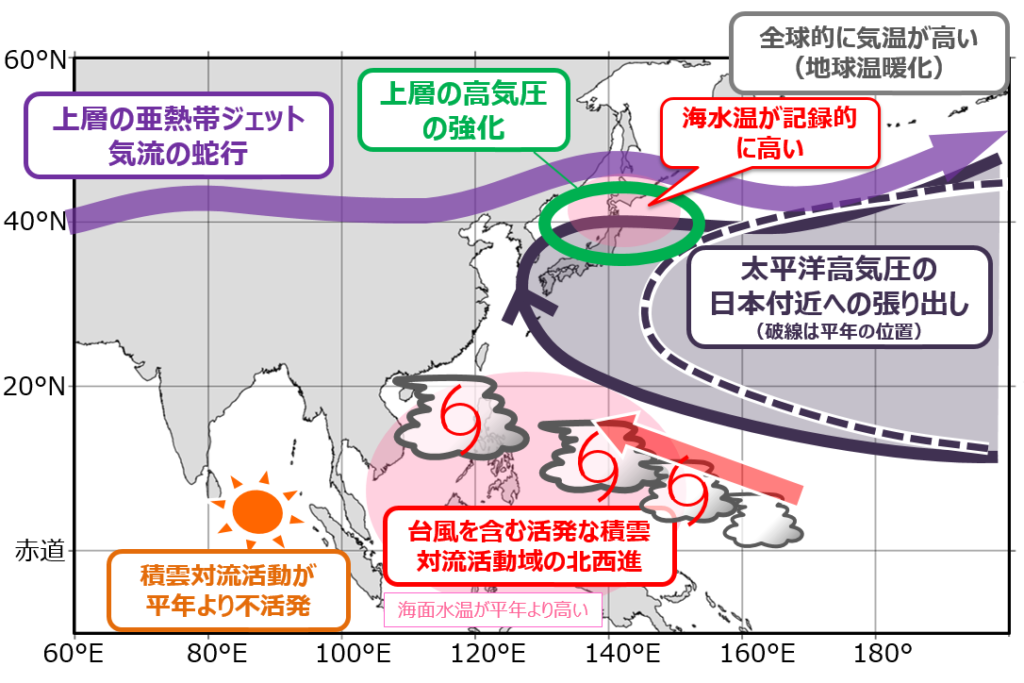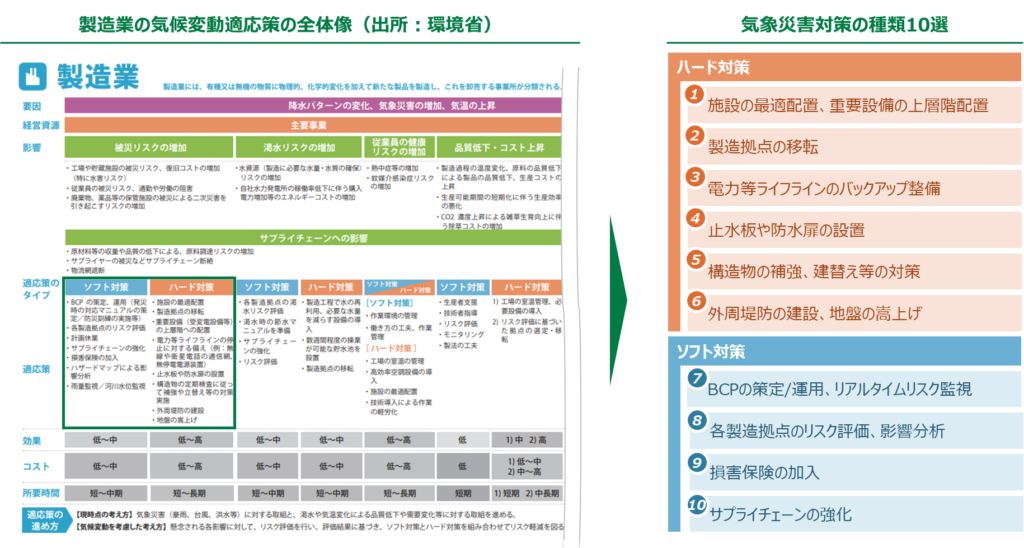Column
2024年01月16日
Summary of Weather Disasters in 2023
This summer has been extremely hot, with the average temperature being the highest since 1898, when observations began. This summer has been unusually hot, and the effects of global warming are believed to have played a role in this. It has also been pointed out that global warming causes more severe weather disasters than just heat. Unfortunately, this summer also saw the occurrence of large-scale weather disasters. First of all, we pray for the earliest possible recovery for those affected. In this article, we summarize the occurrence damage and mechanisms of weather disasters in the summer of 2023 and their relationship with global warming, with the meaning of fostering understanding and awareness of disaster prevention and climate change.
This article is the 2023 version of the following article published in 2022.
Summary of Natural Disasters in Summer 2022|Gaia Vision Inc.
(Reference)
Summer (June-August) weather
Japan Meteorological Agency | Examples of Weather Causing Disasters (1989 – this year)
Summer 2023 Weather Disasters in Japan
Heavy rainfall caused by the front and Typhoon No. 2 (6/1~3)
From June 1 to 3, 2023, a rainy season front and moist air from Typhoon No. 2 caused heavy rainfall mainly on the Pacific Ocean side of western and eastern Japan, and a linear precipitation zone formed in Kochi, Wakayama, Nara, Mie, Aichi, and Shizuoka Prefectures. The heavy rains caused the Yamato River, a first-class river that runs through Nara and Osaka prefectures, to overflow. In addition, more than 8,000 houses were damaged nationwide.

(Source: Japan Meteorological Agency )
The above figure shows a typical pattern that leads to heavy rainfall during the rainy season (a rainy season front stalls over Honshu, while a typhoon approaches from the Pacific side, supplying warm, moist air to the front).
Heavy rainfall caused by rainy season front (6/28~7/16)
Since June 28, the rainy season front and moist air moving toward the front caused heavy rainfall in many areas, and a linear precipitation zone developed in some areas. Nine first-class rivers overflowed, causing damage to 3,082 houses.
On July 13, heavy rains caused a landslide in Toyama Prefecture, resulting in the tragic death of a city council member who was calling for evacuation; on July 15, one person died after being left in his car in Akita Prefecture. Including these, the flooding during this period resulted in 14 fatalities.
(Reference)
Damage situation, etc. related to the heavy rains that began on June 29
Damage situation, etc. related to the heavy rainfall since July 15
Calling residents to evacuate, silent for dead city council member Toyama Nanto | NHK
One Dead in Akita, Man Found in Car, Heavy Rain Continues in Tohoku – Sankei News
Heavy rainfall caused by Typhoon No. 13 (9/7~9)
Heavy rainfall occurred in the Kanto Koshin region and the Pacific side of the Tohoku region from August 8 to 9 due to moist air from Typhoon No. 13. A linear precipitation zone developed in the Izu Islands, Chiba, Ibaraki, and Fukushima prefectures, and heavy rainfall of more than 80 mm per hour fell in some areas. Twenty-six rivers overflowed and 2,929 homes were damaged.
Mechanism of heavy rainfall, relationship to global warming
Heavy rainfall in summer in Japan is mainly caused by rainy season fronts, typhoons, and the resulting influx of warm, moist air.
One of the reasons for the heavy rainfall in many areas during this year’s rainy season, as mentioned above, is thought to be that warm and moist air flowed into the vicinity of Japan in large quantities, causing the rainy season front to become active. The reason for the large inflow of warm and humid air is believed to be the strong westward extension of the Pacific High, which facilitated the flow of large amounts of water vapor along the edge of the high, and the increasing trend of water vapor volume due to long-term global warming. It is also pointed out that the meandering of the jet stream over Japan meandered southward, facilitating the persistence of active convective activity near the front.

Source: https://www.jma.go.jp/jma/press/2308/28a/kentoukai20230828.html
About linear precipitation zones
During the three heavy rainfall events mentioned above, linear precipitation zones occurred and produced locally heavy rainfall. This section describes these linear precipitation zones.
A linear precipitation zone is a rainfall area with strong precipitation that stretches in a linear fashion from 50 to 300 km in length and 20 to 50 km in width, and is created when organized cumulonimbus clouds (cumulonimbus clouds) that develop in rapid succession pass or remain in the same location for several hours. A linear precipitation zone is a rainfall area with strong precipitation that extends 50 to 300 km long and 20 to 50 km wide. Among the several types of linear precipitation zones, this section describes the mechanism of the backbuilding type, which has a particularly high potential to directly lead to disasters. The mechanism of back-building type linear precipitation zones is as follows.
(1) Warm, moist lower-level winds rise in collision with mountainous and cold air, causing cumulonimbus clouds to form.
The cumulonimbus cloud generated in (1) is swept away by the wind above and moves, but the downdraft from the cumulonimbus cloud collides with the lower level wind, and the cumulonimbus cloud is generated again at the same location as in (1).
By repeating (3) and (2), cumulonimbus clouds occur one after another at the same location.
Cumulonimbus clouds generated one after another are swept away by the winds in the sky and fade and disappear as they pass in a linear pattern.
However, there are still many unexplained details of the mechanism, and research is currently underway.
In addition, starting this year, when a linear precipitation zone is expected to occur, a call is issued by the Japan Meteorological Agency about half a day before the expected occurrence. However, with current knowledge and technology, accurate forecasts are difficult to obtain, and improving the accuracy rate is an issue for the future. However, even if a linear precipitation zone does not develop, the possibility of heavy rain remains high, and it is necessary to have a sense of urgency about heavy rainfall disasters when a warning is issued.
Source: Japan Meteorological Agency
Major Flooding Abroad
Such flood disasters are becoming more frequent not only in Japan but also in other parts of the world.
In September 2023, Libya in northern Africa experienced heavy rainfall due to a typhoon-like low pressure system called Medicane (Mediterranean hurricane) that made landfall on 9/10, dumping more than 400 mm of rain in 24 hours at many places. As of 9/23, more than 4,000 people have died and 8,540 are missing.
Thus, the intensification of weather-related disasters due to climate change is an urgent issue not only in Japan but also in the world.
Reference: Libyan floods kill 8,000 people. Why is the damage spreading?
Future Flood Control Measures
Thus, as weather-related disasters continue to become more severe and more frequent, it will be important to determine how to address flood control.
In terms of disaster prevention and mitigation against flood damage, it is necessary to take both hard and soft measures. Hard measures are those that use some kind of structure, such as river revetments or reservoirs, to limit the damage caused by disasters.
In implementing hardware measures, it is important to assess in advance the current flood risk and effectiveness of the measures, as well as the required investment, timeframe, and feasibility of the implementation methods. In public works projects promoted by public agencies, it is necessary to avoid the failure to achieve the expected effects, or the implementation method at the planning stage being difficult to realize, resulting in a significant time lag as a result of reconsideration.
In addition to public works projects, there are many examples of hardscape measures being taken on a company-by-company basis. Examples include moving critical assets and electrical equipment to higher floors, building berms around factories, and raising equipment.
Reference: A collection of case studies of efforts to prevent flood damage (Ministry of Land, Infrastructure, Transport and Tourism)

In recent years, in light of the limitations of hard countermeasures, the importance of comprehensive efforts that include not only hard countermeasures but also soft countermeasures has been increasingly cited. In the context of watershed flood control, the importance of working together with stakeholders in a watershed from both the hard and soft aspects is also being emphasized. It is assumed that damage mitigation can be achieved through the promotion of the sophistication of risk information and the utilization of forecast information.
Reference: Soft measures focusing on damage reduction and resilience improvement (MLIT)
In the private sector, many companies have already developed BCPs, and there have been cases where damage has actually been mitigated. We believe that more and more companies will be working to upgrade their BCP/BCM, taking into account the impact of future climate change.
Reference: Climate Change Adaptation Guide for the Private Sector (Ministry of the Environment)
In 2023, the Weather Forecasting Service Law and the Flood Prevention Law will be partially revised, allowing private companies with certain forecasting technology to provide forecasts for floods and landslides that previously could only be forecast by the Japan Meteorological Agency. This revision of the law enables private companies to provide detailed, quantitative, and real-time flood forecasts at pinpoint locations, which the national government is unable to do, and is expected to encourage private companies to upgrade their BCPs and local governments to utilize these forecasts.
Summary / Gaia Vision Initiatives
This paper provides an overview of the summer floods that occurred in 2023, including an outline of each case, the damage, and the mechanism of occurrence, as well as an organization regarding the direction of efforts to deal with such disasters. Roughly speaking, heavy rainfall occurred in conjunction with the influence of the rainy season front and the occurrence of linear precipitation zones, leading to flooding. While there are cases where flooding occurred in 2023 in frequent flood-prone areas, there are places in Akita Prefecture, for example, where flooding occurred in 2023 while there have been no major floods in the past. In such cases, preparedness may not be sufficient and disasters can easily lead to damage. Even if flooding has not occurred in the past, there are places where the risk is potentially high, and it is important to conduct risk assessments and consider appropriate measures, both hard and soft, taking climate change impacts into account once again.
Gaia Vision aims to reduce the risk of disasters that are becoming more severe due to climate change. We develop and provide climate risk analysis platforms and real-time flood forecasting solutions that utilize global flood simulation technology developed at the University of Tokyo. By utilizing these solutions, local governments and private companies can conduct highly accountable risk assessment, information disclosure, and countermeasure studies that also take climate change into account, as well as provide appropriate evacuation guidance and facility maintenance.
We hope that this report will be especially helpful to those in the manufacturing, infrastructure, real estate, logistics, and construction industries who have multiple global locations, to financial institutions that invest in and finance these companies, and to local governments and public organizations involved in river and crisis management. If you have any questions, please feel free to contact us.
News
- 2025年04月03日 Our technology development project as a partner organization was selected for the “Overseas Demonstration of Satellite Data Application Systems (Feasibility Study),” a technology development theme for which the Space Strategic Fund is soliciting applications from the public.
- 2025年03月07日 ADRC (Asian Disaster Reduction Center) Researchers from Asian Countries Visited Our Company
- 2025年02月21日 ADRC (Asian Disaster Reduction Center) Researchers from Asian Countries Visited Our Company
- 2025年02月17日 ADRC (Asian Disaster Reduction Center) Researchers from Asian Countries Visited Our Company
- 2025年01月29日 Gaia Vision’s efforts for river flow simulation with Kyushu Electric Power Co. reported on the Nikkei news.
Column
-
-
-
-
-

